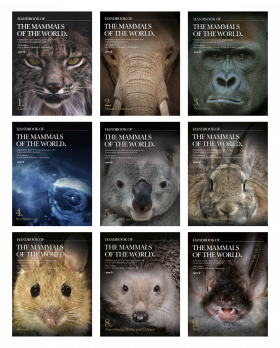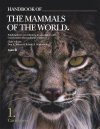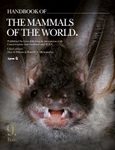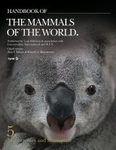World / Checklist Flora / Fauna
By: Don E Wilson(Editor), Russell A Mittermeier(Editor)
727 pages, Col illus, dist maps
![Handbook of the Mammals of the World, Volume 1: Carnivores Handbook of the Mammals of the World, Volume 1: Carnivores]()
Click to have a closer look
About this book
Customer reviews
Biography
Related titles
About this book
This eagerly anticipated first volume in the landmark series deals with the following families:
African Palm Civet; Cats; Linsangs; Civets, Genets and Oyans; Hyenas; Mongooses; Euplerids; Dogs; Bears; Red Panda; Racoons; Skunks; Weasels, Martens, Polecats, Badgers and Otters.
This volume will include an introduction to the Class Mammalia by Don E. Wilson.
Family accounts cover the following: systematics, morphological aspects, habitat, general habits, communication, food and feeding, breeding, movement, home range and social organisation, relationship with humans, and status and conservation.
Species accounts include chapters on taxonomy, descriptive notes, habitat, food and feeding, activity patterns, movements, home range and social organization, breeding, and a bibliography.
Distribution maps, colour photos and colour illustrations throughout.

Volumes 1-9 can also be bought together.
Customer Reviews (1)
-
Authoritative, landmark publication
By
Gehan de Silva Wijeyeratne
23 Jun 2019
Written for Hardback
Handbook of The Mammals of the World is inspired by and follows the general format of The Handbook of the Birds of the World. Both series are invaluable references but also testament to the ambition of the human spirit to seek to catalogue living things in the spirit of scientific explorers in the past. The upside is that the modern cataloguers are equipped with modern tools such as molecular genetics. The downside is they are working in a world which is imperilled by habitat loss and climate change which has put many species at risk. Despite the strong scientific underpinnings and the framework it provides for conservation decisions, both handbook series are accessible and attractive.
As with the volumes on birds, in this opening volume of the mammal series, the text on the families and introductory section is very readable to any person and does not require a science background. Most people with an interest in wildlife will find the family sections of absorbing interest. The species accounts are for reasons of brevity and space more telegraphic in style. They also include details, for example on dentition, which non-specialists can gloss over. The book is liberally illustrated with artwork and a fabulous selection of photographs. The photographs have been selected to show interesting aspects of behaviour. Generally, images chosen are technically strong in terms of composition, focus and exposure and make the book a visual feast as well.
The book although written to work as a single coherent volume is akin to a series of family monographs written by subject matter experts. One of the strengths of the book is the family introduction which is wide in scope and written in an accessible manner to bring together what has been published in hundreds of scientific papers. The bibliography for the entire volume contains more than 4,000 references. The family introductions provide an illuminating portrait at family level. The page count allocated is generous. For example, the section Felidae (cats) runs to 72 pages (pages 54 to 125). The family section follows a standard format covering topics such as Systematics, Morphological Aspects, Habitat, Communication, Food and Feeding, Breeding, Movements, Home Range and Social Organisation, Relationship with Humans and Status and Conservation. The systematics section is well covered given the state of change in classification based on molecular work. In some families simplified phylogenetic diagrams are included, at times together with other linear diagrams with pictures to show the evolutionary relationships. This is one of the sections I like as I want to understand how species fit together. This also interests me as I have written and photographed an identification guide to the mammals of Sri Lanka and I need to keep abreast of taxonomic changes, although sometimes for ease of use, like many authors I may retain an older taxonomy. I appreciate other readers may find some of the other family topics more interesting, such the section on social organisation, which brings together fascinating information based on field work by many scientists.
Each family section is followed by the species accounts, which comprise a series of plates with the species sequentially numbered on the plates followed by the text which has the same sequential number. A plate is the leading page for a cluster of text pages that describe the species on that plate. This makes navigation fairly easy within what is a bulky book. For the cats, the species sections run from page 126 to 168 covering 37 species with 9 plates. The 36 plates are all executed to a high technical standard and the animals look quite lifelike. There is a photo-realism quality to them. These are some of the best mammal plates I have seen and are consistent in quality as they have all been drawn by Toni Llobet. To be drawn by a single artist is an impressive body of work. I can see the plates from the completed series being used for country-level field guides in the future. Each of the species accounts pages also includes the corresponding plate number in the page header to make it easy to find a species account. The genera with the text are also demarcated by large grey shaded boxes. These are a few examples of the thoughtful design considerations to make the book more navigable.
The book begins with an overview of the Class Mammalia, spanning (pages 18-47). This section is liberally illustrated with large diagrams including a cross-section of the skin, skeletons, digestive and respiratory structures, circulation and nervous system. Although it looks like something that belongs in a biology text book, it is written in the same accessible style and is a useful read with a lot of information which mammal enthusiasts would find interesting. For example, it explains how desert-adapted mammals, use air cooling and use mucus in their nose to recapture water. Or you learn that a mouse spends twenty-five times as much energy foraging as a similar sized lizard; a consequence of maintaining an elevated body temperature. Each of the 29 topics in this section has interesting nuggets. The section ends with a brief explanation on speciation, phylogeny and classification with a useful table summarising numbers of genera and species across orders and families. A pie chart on the previous page shows how the rodents and bats make up more than half of all mammal species. The end section comprises the massive list of references (pages 659-716) and the index.
This series as with the bird series works in a way that it is made up of two components for each family, the family description and the species accounts. The species accounts and the accompanying plates lend themselves to being re-packaged in the future to make field guides (in various permutations at the level of scientific orders or geographical units such as countries). The species accounts are mainly for reference and not something that an average person would read through. However, I anticipate people will dip into the species accounts that interest them. They are not without some surprises (unless you have been following the scientific literature). For example, with the Tiger, the text states that there is little evidence for subspecies differentiation in based on recent analyses of morphological and genetic variation. The text notes the five extant subspecies that are currently recognised.
The parts of the volume with the introductory sections and the family accounts are very interesting and in an easy to read style. Carnivores have been a good choice to start this series as they are of such interest and so charismatic that they lend themselves readily to television documentaries. Besides that, owning Volume 1 does leave one with the sense that you are owning the first volume of a landmark series in natural history.
5 of 6 found this helpful
-
Was this helpful to you? Yes No
Biography
Authors:
Jerry W. Dragoo
David L. Garshelis
Philippe Gaubert
Jason S. Gilchrist
Steven M. Goodman
Kay E. Holekamp
Andrew P. Jennings
Roland W. Kays
Joseph M. Kolowski
Serge Larivière
Sue Ruff
Claudio Sillero
Fiona C. Sunquist
Melvin E. Sunquist
Geraldine Veron
Fuwen Wei
Zejun Zhang
Illustrator
Toni Llobet
World / Checklist Flora / Fauna
By: Don E Wilson(Editor), Russell A Mittermeier(Editor)
727 pages, Col illus, dist maps


































![Atlas des Mammifères Sauvages de France, Volume 3: Carnivores et Primates [Atlas of Wild Mammals of France, Volume 3: Carnivores and Primates]](http://mediacdn.nhbs.com/jackets/jackets_resizer_medium/26/263780.jpg?height=150&width=106)


















